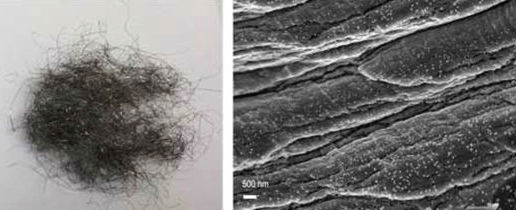|
NOVIDADES
Last year Simona Hunyadi Murph, a UGA researcher and adjunct professor in the UGA Franklin College of Arts and Sciences department of physics and astronomy, successfully turned 'rust into gold' using advanced nanoparticle research methods. The discovery will make the use of nanoscale gold in research settings and industrial applications far more affordable. Murph has now made another nanoparticle breakthrough that could benefit various work environments such as nuclear power plants. Murph and her team have created stainless steel filters treated with nanoparticles that are capable of capturing radioactive vapor materials. Just like air filters capture dust and dirt, these filters are capable of capturing large amounts of radioactive vapors. The new research may one day mean that nuclear power plant workers, and other workers in related fields, will have a safer working environment. “Radioactive materials pose a risk to the environment and living organisms” said Murph, who is also a principal scientist in the National Security Directorate at the Savannah River National Laboratory. “One of the greatest problems associated with radioactive materials is long term storage, disposal or the transformation of this waste into a non-toxic form. Safe capture and disposal has proven to be a formidable task because of the long half-life, toxicity, and high energy emitted from radioactive waste. We believe this to be the first time that nanomaterials have been successfully employed for radioactive vapor capture and sequestration”. A common radioactive component in industrial and nuclear processing is the radioisotope (65) of Zn, which has a wide range of applications. The radioisotope, known as 65Zn, takes nearly 245 days to decay in half, is generated by the neutron-activation reaction of stable zinc (64Zn) in nuclear reactions and can be found in the coolant of atomic power plants. “Nuclear worker safety and environmental protection are the main motivators of this research,” she said. “In order to avoid exposure to research materials, we wanted to develop effective sequestration technologies that reduce potential exposure to the environment and living organisms. We wanted to capture the radiological contaminants in a manner that was designed for them and dispose of them safely”. To create the filter, Murph’s team grew nanoparticles onto supports of stainless steel wool, much like the ones used at home to scrub dishes. Aqueous solutions of gold metal salts were reduced to metallic form using a reducing agent. When this type of preparation procedure is used, she said, it can be scaled up to coat much larger filters. She explained these research methods may be very useful and applicable in the near future.  Gold nanoparticles on supports of stainless steel wool. Image: UGA Additionally, methods or concepts from this research may be applicable to capturing other radioactive materials, cleaning nuclear waste materials, cleaning nuclear waste environments such as rivers and lakes, removing radioactive vapors released in the atmosphere during nuclear accidents like Fukushima, or capturing non-radioactive contaminants found in the semiconductor industry. Nanoscience, she added, provides a way to use nature’s materials to solve complicated problems and she continues to be motivated by the infinite possibilities that this type of research provides her and her team. “I continue to be amazed by the exceptional opportunities that the field of nanoscience and nanotechnology has to offer,” she said. “Driven by the continuous demands of society to find new and intriguing substances that can cure disease, help us explore or live in space, make us live longer and healthier lives or discover new energy supplies, the evolution of this astonishing field will continue.” “The ability to manipulate atoms at the most fundamental level is fascinating and provides infinite technological possibilities,” she added. “I believe that the promise of viable applications for the future lies in the ability of scientists to understand, generate, and control materials at the nanoscale. By creating productive, cost-effective, light-weight materials that are stronger, harder, and safer in a controlled, reproducible way, nanotechnology has the potential to revolutionize manufacturing technology. Want to know more about research in this field? You can view this and other research findings in a recently released book titled Anisotropic and Shape-Selective Nanomaterials: Structure-Property Relationships (Nanostructure Science and Technology). The study was also published in the journal JOM ("Nanoparticle Treated Stainless Steel Filters for Metal Vapor Sequestration") and was selected as one of the “top ten ranked papers” by the journal’s Editors. |
|||||||||||||||||||||||||